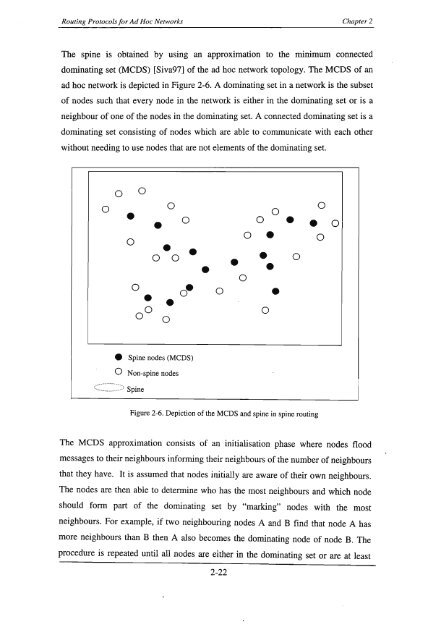Gugrajah_Yuvaan_ Ramesh_2003.pdf
Gugrajah_Yuvaan_ Ramesh_2003.pdf
Gugrajah_Yuvaan_ Ramesh_2003.pdf
Create successful ePaper yourself
Turn your PDF publications into a flip-book with our unique Google optimized e-Paper software.
Routing Protocols for Ad Hoc Networks Chapter 2<br />
The spine IS obtained by using an approximation to the minimum connected<br />
dominating set (MCnS) [Siva97] of the ad hoc network topology. The MCnS of an<br />
ad hoc network is depicted in Figure 2-6. A dominating set in a network is the subset<br />
of nodes such that every node in the network is either in the dominating set or is a<br />
neighbour of one of the nodes in the dominating set. A connected dominating set is a<br />
dominating set consisting of nodes which are able to communicate with each other<br />
without needing to use nodes that are not elements of the dominating set.<br />
0<br />
0<br />
0<br />
0<br />
0<br />
• 0<br />
• 0 0 • 0<br />
• 0 • 0<br />
0<br />
• • • 0 0 • •<br />
0<br />
• 0<br />
0<br />
•<br />
o· •<br />
0<br />
• 00<br />
0<br />
0<br />
• Spine nodes (MCDS)<br />
0 Non-spine nodes<br />
:> Spine<br />
Figure 2-6. Depiction of the MCDS and spine in spine routing<br />
The MCnS approximation consists of an initialisation phase where nodes flood<br />
messages to their neighbours informing their neighbours of the number of neighbours<br />
that they have. It is assumed that nodes initially are aware of their own neighbours.<br />
The nodes are then able to determine who has the most neighbours and which node<br />
should form part of the dominating set by "marking" nodes with the most<br />
neighbours. For example, if two neighbouring nodes A and B find that node A has<br />
more neighbours than B then A also becomes the dominating node of node B. The<br />
procedure is repeated until all nodes are either in the dominating set or are at least<br />
2-22
















